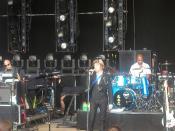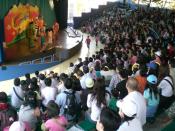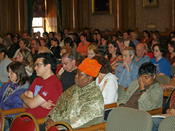A film director has a very difficult job. He is to find some way to combine a multitude of elements like image, sound and the passage of time to create a story and he must do it in such a way that, when it is presented to a large group of different people, it can elicit a common emotional response through them all. If a director hopes to succeed at his art, he must learn what is needed when in a scene and what kinds of response his choice with get from an audience. Scott Hicks understands this perfectly and his 1996 film, Shine, is a brilliant demonstration of his skill. The places where his emotional manipulation is especially apparent are during the three high emotion scenes; the encounter between David and his father in the bathtub, David's performance of Rachmaninov's Concerto No. 3, and when David is playing on the trampoline at Sylvia's.
Shine is a film steeped in music. Whether it is intrinsic or extrinsic, an undercurrent to a scene or the focus of the scene itself, it was almost a constant presence. For this reason, when Hicks chose to remove the music in the scene between David and his father in the bathtub, it immediately drew the viewer's attention simply due to the stark contrast it had to the rest of the film. Silence left a much deeper impression here than any piece of dramatic music could, and Hicks knew that. A second technique he employed was combining arbitrary shots of the bathroom and multiple camera angles and continually crosscutting them. By doing this, he was able to give the audience a sense of how David was feeling. The chaotic cuts and the random focus of the shots mirrored David's thoughts and mind-set and instilled a sense...


